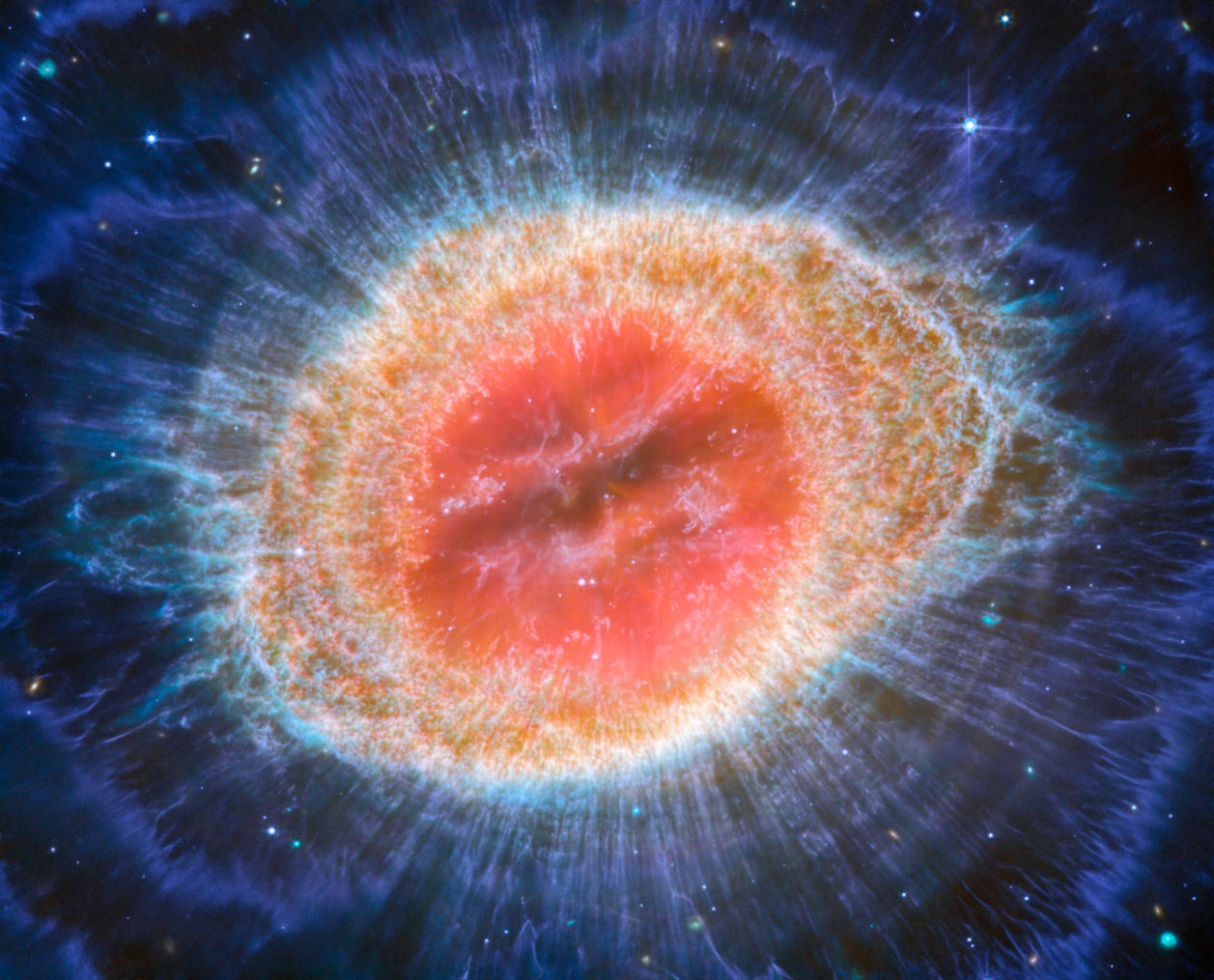NASA’s James Webb Space Telescope has captured the famous Ring Nebula in unprecedented detail. The Ring Nebula consists of a star shedding its outer layers as it runs out of fuel, and is a typical planetary nebula. This new image from Webb’s NIRCam (Near Infrared Camera) shows intricate details of the structure of the inner ring filaments. There are about 20,000 dense spheres in the nebula, which are rich in molecular hydrogen. In contrast, the inner region shows a superheated gas. The main shell contains a thin ring of enhanced emission of carbon-based molecules known as polycyclic aromatic hydrocarbons (PAHs). Credit: ESA/Webb, NASA, CSA, M. Barlow (University College London), N. Cox (ACRI-ST), R. Wesson (Cardiff University)
NASA‘s James Webb Space Telescope It reveals the intricate details of the ring nebula, suggesting the role of binary companions in shaping the complex structures of planetary nebulae.
NASA’s James Webb Space Telescope has obtained images of the Ring Nebula, one of the most famous examples of a planetary nebula. Much like the Southern Ring Nebula, one of Webb’s first images, the Ring Nebula displays the intricate structures of the final stages of a dying star. Roger Wesson of Cardiff University tells us more about this phase of the sun-like star’s stellar life cycle and how Webb’s observations have given him and his colleagues valuable insights into the formation and evolution of these objects, suggesting a key role for binary companions.
Planetary nebulae were once thought to be simple, round bodies with a single dying star at the center. They are named for their vague, planet-like appearance through small telescopes. Just a few thousand years ago, that star was still a red giant losing most of its energy. As a final farewell, this hot center of expelled gas ionizes or heats up, and the nebula responds with a colorful emission of light.However, recent observations show that most planetary nebulae display incredible complexity.The question arises: How could a spherical star create such non-spherical structures complex and delicate?

This new image of the Ring Nebula from Webb’s MIRI (Medium Infrared Instrument) instrument reveals particular details in the concentric features in the outer regions of the Ring Nebula. Roughly ten concentric arches lie behind the outer edge of the main ring. The arcs are thought to arise from the interaction of the central star with a low-mass companion star orbiting at a distance similar to that between Earth and Pluto. CSA, M. Barlow (University College London), N. Cox (ACRI-ST), R. Wesson (Cardiff University)
“The Ring Nebula is an ideal target for unraveling some of the mysteries of planetary nebulae. It is nearby, about 2,200 light-years away, bright and visible with binoculars on a clear summer evening from the northern hemisphere and much of the south. Our team, the ESSENCE team JWST), is an international group of experts on planetary nebulae and related objects. We knew that Webb’s observations would provide invaluable insights, since the Ring Nebula fits so well into the field of view of Webb’s NIRCam (Near Infrared Camera) and MIRI (Near Infrared Camera) instruments. mid-infrared), allowing us to study it in unprecedented spatial locations. Details. Our proposal to observe it (GBP 1558) was accepted, and Webb captured images of the Ring Nebula a few weeks after science operations began on July 12, 2022.
“When we first saw the images, we were amazed at the amount of detail in them. The bright ring that gives the nebula its name is made up of some 20,000 individual clumps of dense molecular hydrogen gas, each about the size of an Earth’s mass. Within the ring, there is a narrow band of emissions from polycyclic aromatic hydrocarbons, or polycyclic aromatic hydrocarbons, complex carbon-bearing molecules that we wouldn’t expect to form in the Ring Nebula.Outside the bright ring, we see strange “bumps” pointing directly away from the central star, which are prominent in the infrared but were very faintly visible in the Hubble Space Telescope the pictures. We think this may be due to particles that can form in the shadows of the denser parts of the ring, where they are shielded from direct, intense radiation from the hot central star.
“Our MIRI images provided us with the clearest and sharpest picture yet of the faint molecular halo outside the bright ring. The surprising revelation was that there are up to ten regularly spaced concentric features within this faint halo. These arcs must have formed approximately every 280 years as The central star was shedding its outer layers. When a single star develops into a planetary nebula, there is no process that we know of that has this kind of time period. Instead, these rings indicate that there must be a companion star in the system, orbiting the central star far away about the central star Pluto does from our sun. As the dying star shed its atmosphere, the companion star shaped and sculpted the outflow. No previous telescope had the sensitivity and spatial resolution to detect this subtle effect.
“So how did a spherical star form such orderly and complex nebulae as the Ring Nebula? A little help from a binary companion might be part of the answer.”
Authors
- Roger Wesson is a Research Associate in the School of Physics and Astronomy at Cardiff University, UK, and an ESSENcE Co-Investigator.
- Mikako Matsuura is a Reader (equivalent to Associate Professor) at the School of Physics and Astronomy, Cardiff University, UK, and an ESSENcE Associate Investigator.
- Albert Zylstra is Professor of Astrophysics at the University of Manchester, UK, and Research Associate in the ESSENcE programme.
NB: This article highlights data from an in-progress web science that has not yet been through the peer-review process.

“Amateur organizer. Wannabe beer evangelist. General web fan. Certified internet ninja. Avid reader.”






More Stories
‘It gave me goosebumps’: The most powerful gamma-ray burst ever observed was hiding a secret, scientists say
Astronauts Are Finding Their Taste Has Become Dull, and ISS VR Hints at Why
EEE Found in Connecticut Mosquitoes for First Time This Season – NBC Connecticut